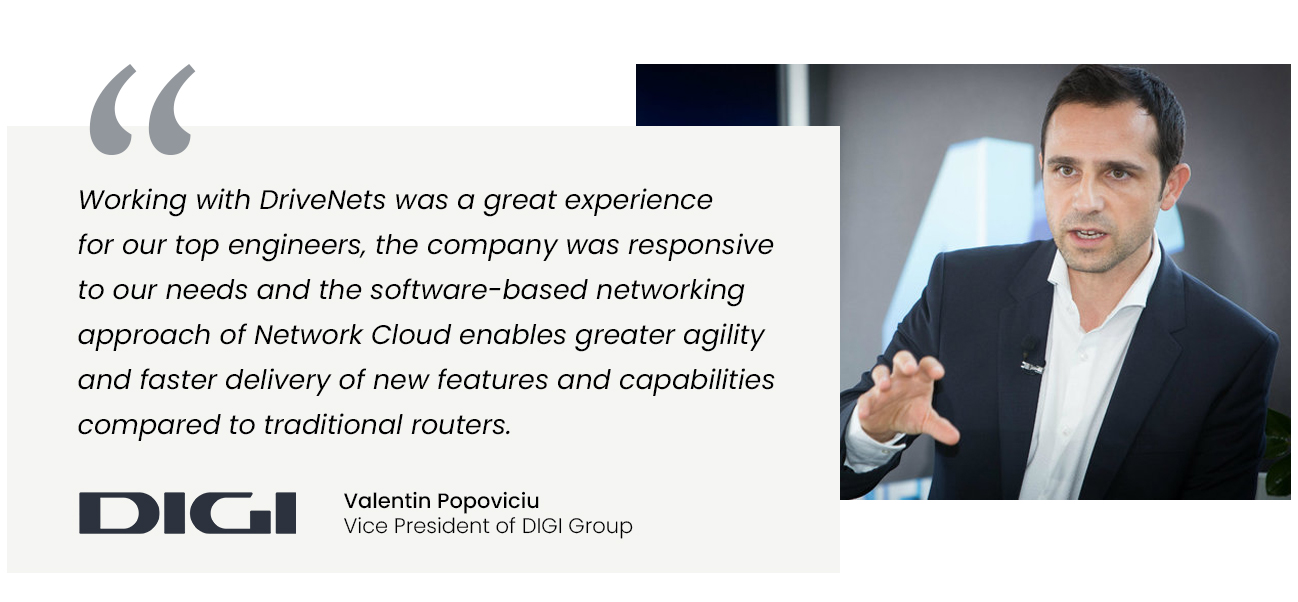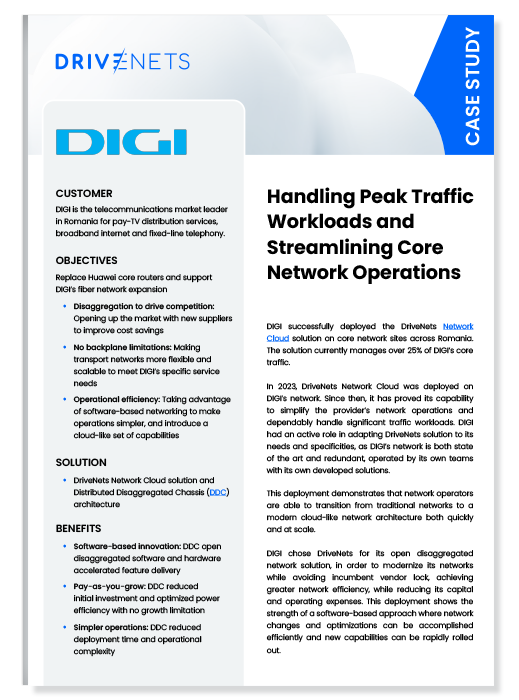Case StudiesMarch 1, 2024
DIGI: Handling Peak Traffic Workloads and Streamlining Core Network Operations
CHALLENGES
Aiming to enhance its core network infrastructure, DIGI faced a series of challenges that they needed to address in order to ensure the successful replacement of Huawei core routers. These challenges included:
- Break vendor lock: The goal to open up the market by introducing new suppliers presented a significant challenge. This shift aims to drive competition and achieve cost savings, by leveraging the benefits of disaggregation.
- Overcome backplane limitations: Traditional transport networks come with backplane limitations that can hinder flexibility and scalability. For DIGI, there was a clear need to develop a more adaptable and scalable network infrastructure that could specifically meet its evolving service scale demands without the constraints of traditional hardware limitations.
- Achieve operational efficiency: Transitioning to software-based networking presented its own challenges. While the promise of operational simplicity and the introduction of cloud-like capabilities were appealing, realizing these benefits required overcoming the complexities associated with implementing and managing software-driven network operations.
Each of these challenges needed to be meticulously addressed to ensure that DIGI’s network could not only accommodate current demands but also be future-proofed for scalability and innovation.
SOLUTION
Faced with the challenges of upgrading core routers and overcoming the limitations of traditional network infrastructures, DIGI embarked on a transformative journey with DriveNets field-proven Distributed Disaggregated Chassis (DDC) solution. DDC’s effectiveness and reliability have been validated in multiple real-world scenarios, demonstrating its capability to meet modern network demands with minimal risk. The decision to adopt DriveNets’ open disaggregated network solution marked a pivotal shift towards modernizing DIGI’s network operations, with a clear focus on avoiding vendor lock, enhancing network efficiency, and significantly reducing both capital and operating expenses.
By deploying DriveNets Network Cloud across core network sites in Romania, DIGI streamlined its network operations, now managing over 25% of its core traffic through this innovative platform. Since its deployment in 2023, DriveNets Network Cloud has already shown how the solution can simplify core network operations and reliably handle substantial core traffic workloads, demonstrating the power and efficiency of software-based network solutions. This agility enables rapid rollout of new capabilities, significantly improving network performance. DIGI’s successful deployment of DriveNets Network Cloud is a testament to the solution’s ability to not only meet current network demands but also adapt swiftly to future requirements, ensuring a scalable and flexible network infrastructure.
Highlighting the growing momentum of network disaggregation across the industry, Roy Chua, founder and principal analyst at AvidThink observed, “Network disaggregation isn’t only for the Tier-1 operators of the world; it’s gaining momentum across the entire industry and across the globe. The successful rollouts of DriveNets Network Cloud at DIGI shows that cloud-like networks can outperform traditional networks while significantly increasing service agility and cost optimization for operators of all sizes” Through this deployment, DIGI positioned itself at the forefront of network innovation, demonstrating the scalability, efficiency, and flexibility that future networks demand.
RESULTS
By deploying DriveNets Network Cloud, DIGI has achieved the following benefits:
- Fastest transition ever from trial to production: The solution enabled a live traffic trial in just a few weeks.
- No vendor lock: With DDC, DIGI was free to mix and match from a wide range of ASICs, hardware, software, and optics, eliminating vendor lock and encouraging a competitive, innovative environment.
- Incremental scalability: DDC supports scalable network growth with cost-effective, incremental capacity upgrades using standard white boxes as building blocks, optimizing capital expenditure.
- Unified HW from core to edge: DIGI applies DDC’s unified hardware approach throughout its core network, using standard white boxes. In future projects across various network domains, DIGI could leverage the same white box building blocks to construct routers of any size. This approach reduces the number of network components, lowers inventory costs, streamlines the supply chain, and simplifies warehousing.
- Higher availability: DIGI’s network achieves high network availability with its DDC distributed structure and redundancy, simplifying maintenance by replacing individual white boxes instead of entire systems.
- Software-based innovation: DDC introduces a software-based, cloud-native network architecture, offering DIGI unprecedented flexibility and agility for rapid service deployment and integration.
 |
SUMMARY
As the first operator in Romania to deploy a disaggregated IP infrastructure, DIGI highlighted three key elements with which they were very satisfied, throughout the project:
- Familiar network operation environment: DIGI aimed to enhance network flexibility and redundancy while ensuring that engineers could maintain familiarity with legacy network element operation. The operator requested the ability to manage network elements directly through a single command-line interface (CLI), akin to a traditional router. DriveNets Network Cloud DDC offers familiar network operation with improved agility.
- Robustness of DDC solution: Encouraged by the reported network measurements already in production and the robustness of DDC’s design, DIGI were very impressed with the robustness of DDC architecture in its core network.
- Responsiveness: The collaboration between DIGI and DriveNets exemplifies how tailored solutions and proactive support can facilitate seamless network transformations. DriveNets’ ability to listen and adapt to DIGI’s specific needs, from technical requirements to operational preferences, has been instrumental in achieving the desired outcomes of its network modernization efforts.
DIGI’s collaboration with DriveNets represents a forward-looking approach to network transformation, demonstrating the significant advantages of adopting a disaggregated, software-centric networking model. This case study serves as a blueprint for other service providers seeking to navigate the complexities of network modernization, offering valuable insights into the strategic planning, implementation, and benefits of such an undertaking.







